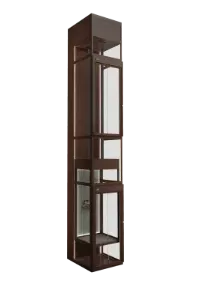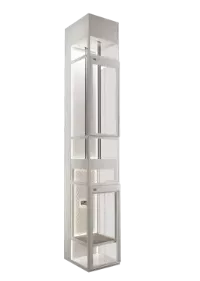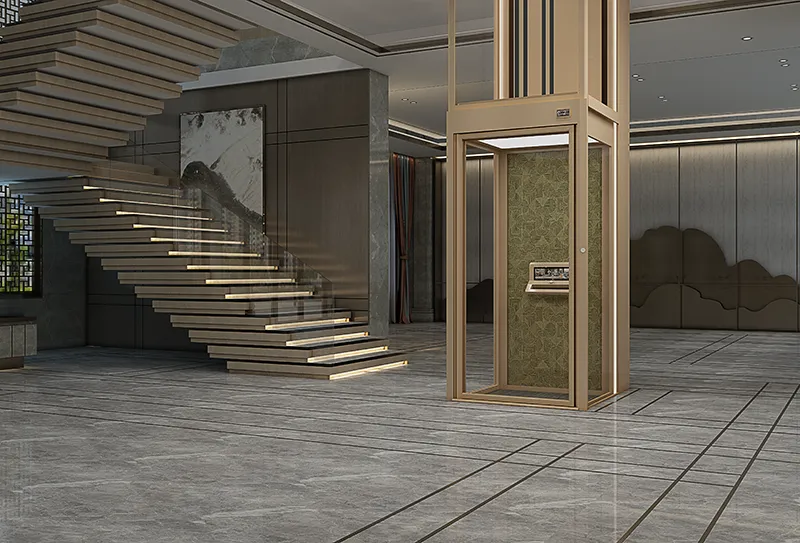Home elevators are divided into hydraulic villa elevators, traction villa elevators, and imported screw elevators. Next, we will briefly compare the advantages and disadvantages of these elevators.
Advantages of screw-type home elevators
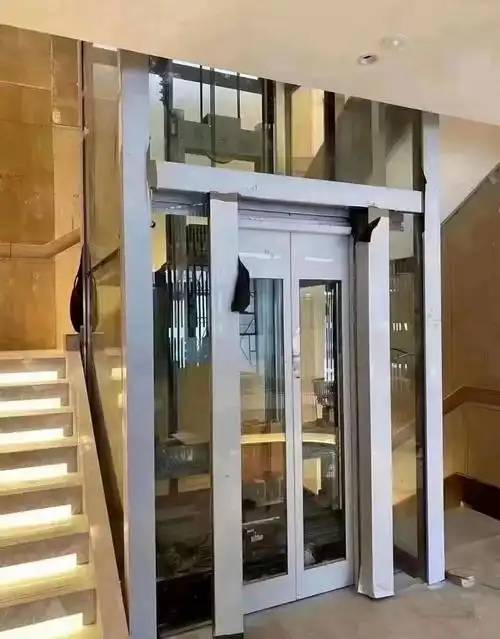
- Save building area
The screw drive should be the most building-saving home elevator product in China. There is no counterweight, no wire rope, and no car wall, so the minimum installation space only needs 1000X900 mm to install a screw-type home elevator.
- Low civil engineering requirements
The screw-type home elevator has a slow running speed, and because of the advantages of the mechanical structure, it is relatively safe, so there is no need for buffers, speed limiters and other devices, so there is no need to dig elevator foundation pits. Only the height of a decoration surface is required (50 mm), and there is no need to make a special load-bearing ring beam. As long as there is a wall, it can be installed, especially the top floor height, which can be as low as 2000 mm.
- Flexible structure, stable and reliable
Screw-type home elevators can easily open doors at right angles, through doors, and 3-sided doors without affecting the stability of the elevator or increasing the shaft area. Screw-type home elevators have a simple structure, are not prone to failure, have fewer wearing parts, and save customers the trouble of later maintenance and repair. As for safety performance, screw-type home elevators are known to never fall off the ladder. From the perspective of its main structure, it is indeed safer and more reliable (mainly about imported screw-type elevators)
Disadvantages of screw-type home elevators
1: There is a certain amount of mechanical noise
Since the motor follows the platform, the mechanical noise of the motor is inevitably transmitted to the user's ears, but many users can hear this sound. If users who are very particular about quietness and obsessive-compulsive disorder may not be able to adapt to screw-type elevators.
2: The running speed is relatively slow
Due to the limitations of the mechanical structure, the running speed of screw-type home elevators cannot be too fast, and can only be 0.15-0.25 meters per second at most, which is half the running speed of 0.4 per second for traction type. If users who want to pay attention to efficiency, they probably won't like it too much.
3: The comfort is a little worse than the traction type and hydraulic type
The platform and the screw are directly connected together, and the mechanical vibration will be transmitted to the platform. Although it is not very obvious, it does not feel as soft and smooth as the traction type or hydraulic type, and it feels a bit hard.
Advantages of traction home elevators:
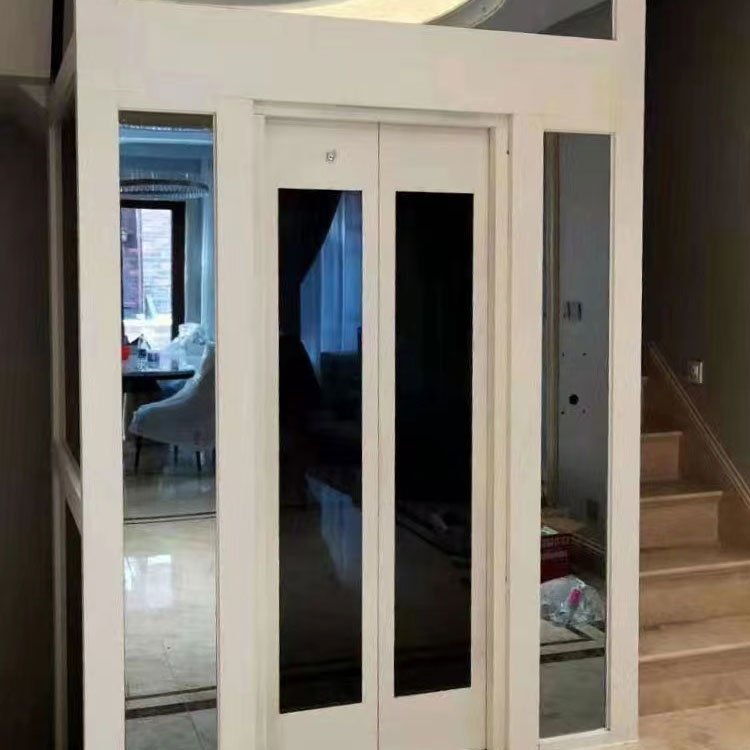
- Quiet and stable
The traction drive is relatively quiet (but there are some differences between different brands of elevators). The permanent magnet synchronous host has no reduction box, and there will be no mechanical sound of gear friction. As long as the installation and debugging are in place, it will run very smoothly. The motor completely relies on frequency conversion and voltage conversion to adjust the speed, and a very perfect operating speed curve can be adjusted.
- Energy saving and environmental protection
The permanent magnet synchronous host does not need to add and replace the oil regularly, so there is no possibility of oil leakage. The motor power is relatively small, only more than 1 kilowatt, which is very energy-saving. A family installs a traction elevator, and the electricity bill is at most 20 yuan a month.
- Relatively affordable price
Since permanent magnet synchronous host is the current development trend of the elevator industry, all major manufacturers are developing and producing traction elevators. At present, it has caused overcapacity and supply exceeds demand, so this price is more affordable than hydraulic (but it also depends on the brand, the price difference of elevators of different brands is still very large)
Disadvantages of traction home elevators:
- High requirements for civil engineering. For example, if the top floor height of the customer's house is too low (less than 2800), it cannot be installed, and the foundation pit depth must be more than 300 mm
2: Occupied space size Traction elevators must have a counterweight device, so 2 rails must be added. In this way, it takes up a little more space than hydraulic elevators, generally 150 mm more than hydraulic ones. It is impossible to install it in a narrow space (less than the inner diameter of the well of only 1400X1100). In addition to the space occupied by the counterweight, there is also a minimum size limit for the base of the host.
3: The quality of traction elevators varies. The mainstream of the market is traction elevators, and everyone is making traction elevators. There are too many brands, and some manufacturers engage in price wars to reduce costs, and finally can only sell inferior products as good ones. Another point is the safety issue of traction elevators. If they are equipped with inferior host and control system, there is a possibility of brake failure and uncontrolled operation.
Advantages of hydraulic home elevators:
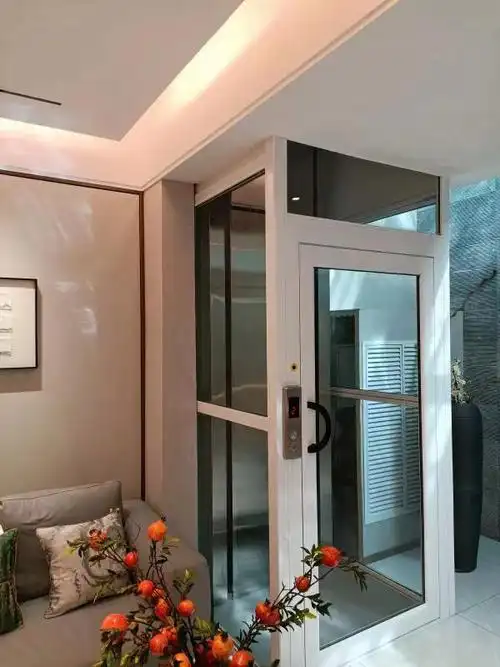
- Hydraulic elevators have low requirements for civil engineering structures
It does not require a machine room, only a load-bearing wall, and can be installed as long as the top floor height is more than 2,600 mm. The foundation pit can also be very shallow, with a minimum of 100 mm foundation pit. Due to the advantages of hydraulic home elevators in low civil engineering, they quickly occupied most of the home elevator market when they were introduced to China ten years ago.
- Hydraulic elevators will not overspeed and lose control, and it is easy to achieve self-rescue
There will be no top-to-bottom collisions. As long as the mechanical structure is reasonably designed and the installation is reliable, the safety factor of hydraulic elevators is relatively high. In addition, hydraulic elevators can use backup batteries to achieve the self-rescue function of trapped people. When the elevator fails or the power is cut off, press the emergency button inside the car, and the hydraulic oil after the oil drain valve circuit is connected slowly returns to the oil tank. The elevator will slowly descend by its own weight.
- Hydraulic elevators can save building space
Traction elevators have counterweight devices, while hydraulic elevators do not have counterweight devices. They only have two tracks, so they can save space (if the middle of the stairs is only 1400X1100, it can also be installed)
Disadvantages of hydraulic home use:
1: There is a certain amount of motor noise
If the pump station is not isolated or far away from the shaft, the mechanical sound of the motor and oil pump when the elevator starts to go up will be very clear, forming noise pollution
2: The sealing ring will leak a little hydraulic oil
After the service life of the cylinder piston expires, or there is wear and tear, the hydraulic oil will leak into the shaft, which is quite troublesome to repair, and is not conducive to environmental protection.
3: The comfort is not perfect
The speed regulation of the hydraulic ladder is adjusted by the oil volume and pressure of the pump station pump, so the elevator feels shaking or sinking when it is running.
By comparing the advantages and disadvantages of screw, traction and hydraulic elevators, users can choose the appropriate product according to their own situation. If the civil engineering is large enough, especially for villa owners who have reserved elevator shafts, a traction home elevator is the best choice.

